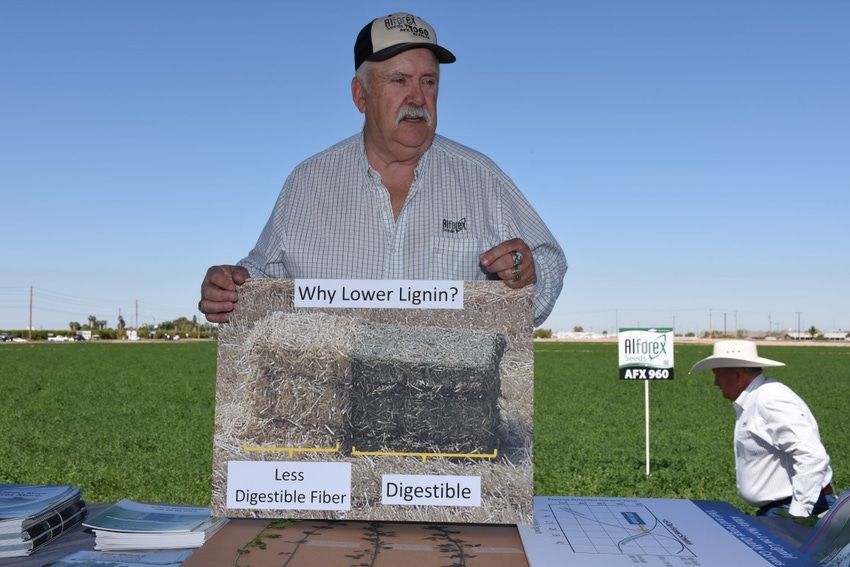June 26, 2017

Alforex Seeds, the forage seed company of Dow AgroSciences, held an alfalfa field day early this summer in Yuma, Ariz., hosted by John Daily Farms, to explain and demonstrate the company’s new Hi-Gest low lignin alfalfa varieties currently available to Arizona and California growers.
The event drew a good turnout as plant breeder and agronomist Don Miller, Alforex’s director of product development, described the company’s low lignin variety’s AFX 960 and AFX 1060 which were planted onsite.
“Alforex Seeds’ low lignin alfalfa varieties produce from 7 percent to 10 percent less lignin than traditional varieties,” Miller said. “When fed to dairy and beef animals, our low lignin alfalfa improves forage digestibility by the animal.”
Better digestibility, Miller noted, can produce more milk or meat per animal for the livestock producer. In turn, this could return higher dollars to the alfalfa grower for the low lignin alfalfa.
According to Alforex Seeds, lignin is a complex organic compound which binds cellulose fibers and other cell wall polysaccharides to harden and strengthen the cell walls of alfalfa plants. It provides plants the structural support to grow taller.
Miller said the 7 percent to 10 percent lignin reduction in Alforex low lignin varieties does not negatively affect the plant’s ability to stand upright.
Alforex launched research for low lignin varieties in 2005. The AFX 960 and AFX 1060 varieties on the market today were developed using conventional breeding (non-transgenic). The company received a patent early this summer for its third low lignin variety – AFX 660.
“Low lignin alfalfa opens up a lot of opportunities for the producer,” Miller said. “These new genetics are performing well and delivering better digestibility and animal performance.”
Another benefit of Alforex low lignin alfalfa is more flexibility for growers at cutting time, the plant breeder said. While alfalfa in the low desert in the West is generally cut about every 28 days, cuttings can be delayed up to seven days if inclement weather occurs, without sacrificing forage quality.
Miller explained that for dairy producers using very aggressive cutting intervals (prebud) to improve quality during the summer months that harvest intervals can be extended a few days to improve yield and reduce plant stress while still a achieving forage quality.
He said, “Our low lignin alfalfa gives the alfalfa grower more opportunities and harvest flexibility.”
Low lignin alfalfa provides a higher leaf-to-stem ratio with about 5 percent to 8 percent more leaves per plant, Miller said. This helps improve the plant’s crude protein by about 3 percent to 5 percent.
Alfalfa field day host John Daily farms about 6,500 acres, including about 1,600 acres of alfalfa, plus cotton, Sudangrass, wheat, and onion seed. At the event, Daily talked one-on-one with growers about the Alforex varieties he planted in October 2016.
“Anytime there is a new variety I’m interested in trying to see if it has the potential to improve alfalfa yield and quality,” Daily said. “We are trying to find a niche and there could be a good niche for low lignin alfalfa.”
Daily said a major challenge for the Alforex varieties will be the extreme heat in the low desert. Temperatures in the Yuma area average 110 to 115 degrees during the summer months.
“The summer heat will be a really good test for it,” Daily said. “It gets very hot here and we’re in high saline, sandy soils. We’ll see how the Alforex low lignin varieties perform through the summer.”
You May Also Like




